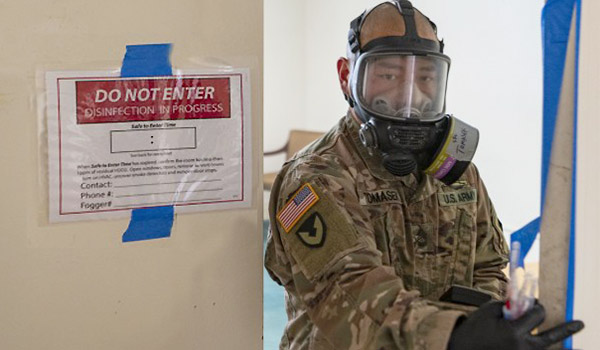
Ask the Flight Surgeon / By CPT Frank C. Stafford, D.O.: Q: What is this coronavirus and COVID-19? Why is it in the news? Is it dangerous and what should I do about it?
FS: Human coronaviruses (CoV) are a large family of viruses that can cause a variety of illnesses ranging from the common cold to severe diseases like Middle East respiratory syndrome (MERS-CoV) and Severe Acute respiratory syndrome (SARS-CoV). The new novel coronavirus that produces the infection known as COVID-19 is designated as SARS-CoV-2 by the Centers for Disease Control and Prevention––. This virus may have moved from animals to humans. Specifically, it may have jumped from bats with possible movement to other mammals and then to humans. The initial outbreak COVID-19 was in Wuhan, Hubei Province, China.
Why is COVID-19 in the news?

The West Virginia National Guard trained staff at the Children’s Home Society in Romney on the proper use of personal protective equipment (PPE)
This virus has proven to be unique in many ways. Initially, it was thought that it was only spread through contact at local animal markets. However, person-to-person spread has been seen inside and outside China to include Europe, India, Australia, South and North America, Scandinavia and Russia. At the time of this writing, a total of 3,100 COVID-19 infections have been noted in the U.S. across 49 states and Washington, DC. This quick spread into multiple countries and the potential for larger spread among humans has garnered a lot of media attention. Additionally, many of the countries impacted have implemented travel restrictions, travel recommendations and protocols involving the quarantining of people that were exposed and isolation of confirmed cases.
Is COVID-19 dangerous?
The infection in the U.S. mirrors what has been seen in other countries. The overall mortality rate is relatively small. This is less than other similar infections seen in the past such as avian flu, swine flu (H1N1), MERS-CoV and SARS-CoV.
Symptoms can vary widely. Some infected individuals never have symptoms (this may aid its spread), while others may have cold/flu like symptoms. Unfortunately, some experience severe respiratory symptoms that can lead to death. The most common symptoms include fever, difficulty breathing (dyspnea) and non-productive cough. Other symptoms could include muscle aches, joint aches, fatigue, headache and other flu-like symptoms. As noted above, most patients report mild symptoms and are able to recover without any issues. The seriousness of the infection increases in patients that are older and people that already have other medical conditions. These conditions can include diabetes, heart disease, lung disease, steroid use and any other medication or disease that impairs the immune system.
Individual states and Washington, DC are now able to detect the COVID-19 virus through laboratory testing.
What is the bottom line and what should I do about it?
This infection can be transmitted from person-to-person and can make people sick for a few days. This transmission makes this a public health concern. If this infection were to get into any community or any public gathering where “close contact” is maintained, it could easily spread and cause a large amount of sickness. This has some possibility of taxing the medical system in the area. That is why you see many public events being limited or cancelled as well as different groups cancelling meetings and the government limiting travel; all helping to limit the spread of the virus. You should also understand that “close contact” is defined by the CDC as someone that lives in the same home with a confirmed case, being within 2 rows of seats on an airplane either forward or back of a confirmed case, being within six feet of a confirmed case for a prolonged time, or having direct contact through being coughed on or other direct exposures to an infected person’s secretions.
You can do many things to protect yourself as well as those around you. First, you should maintain good hand washing hygiene and avoid touching your face with your hands. Also, avoid contact with those showing symptoms of COVID-19. Next, you should consider limiting your travel and follow the guidelines on what precautions to use when flying to other countries as given on the CDC website. The final suggestion is to be mindful of how you feel. If you feel like you have symptoms, you can socially distance yourself and not expose others. The CDC recommends a 14-day quarantine for those suspected of exposure to COVID-19. This means avoiding any areas where others would be within 6 feet of your person for a prolonged time period, meaning nothing more than a quick in and out of that area.
Last but not least, education is always a great defense so continue to monitor official sites such as the CDC (which is referenced below) for the most up to date information. As always, seek medical care if your health deteriorates beyond what you would consider outside the realm of a routine illness.
Fly Safe!
Question for the Flight Surgeon?
If you have a question you would like addressed, email it to This email address is being protected from spambots. You need JavaScript enabled to view it.; we’ll try to address it in the future. See your unit flight surgeon for your personal health issues.
The views and opinions offered are those of the author and researchers and should not be construed as an official Department of the Army position unless otherwise stated
CPT (Dr.) Frank C. Stafford is a flight surgeon at the School of Army Aviation Medicine, Fort Rucker, AL
















